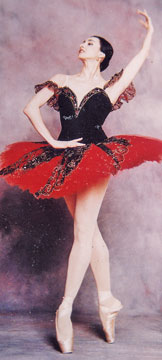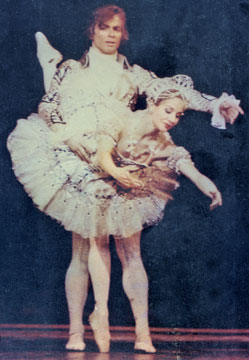Music and movement in the world ballet scene
by Gwen Herat
 |
|
Nina Ananiashvili in ‘Don Quixote’ in
the highly developed ballet mounted in Australia by Rudolf
Nureyev and many others. |
Jean-Baptist Lully was the founder of a National French school which
from the beginning chose ballet for its medium. From 1653 when he became
the Court composer, he wrote long ballets and masques in many
productions Louise XIV participated. The king's influence motivated many
composers who took up the challenge to score for ballet. Another
composer whose work set him apart in his generation was Gluck. His
contribution in the area of ballet scores is considerable.
The great combination of choreography and scores, depend on each
other to achieve glory and perfection. A choreographer usually creates a
ballet around existing music rather than commission a composer to write
a special score. Even symphonies have been popular especially written
during the classical and romantic eras as an air of youth, romance and
freshness though played over and over.
We do not usually associated Mozart with ballet although in his
opera, Idomeno he inserted a ballet with a suite of five numbers. Yet,
Mozart was more acquainted with ballet than most people think and
together with his wife, they danced at balls and were present at many
ballet programmes.
In fact, he wrote music for Noverre's ballet, 'Les Petits Riens'.
Beethoven was yet another master who composed for ballet with The
Creatures of Prometheus' being one of his major works. Beethoven was not
a ballet composer as his music was gentle, light and easy on the ear and
had little understanding of the requirement for movements.
As far as the creation of dramatic symphonic music for ballet, few
composers had affinity towards its task. But Delibus and Tchaikovsky
showed that ballet music could create drama. Then Tchaikovsky composed
the score for 'Swan Lake', it went down like a magical journey to date
as every composer from then onwards, never opted for any thing other
than Tchaikovsky's score. For instance, Kenneth MacMillan said to good
ballet scores from earlier music than from the nineteenth century
scores, were possible.
It is a marvellous feeling to note that music remains distinct from
any time before 1960. It owes its credit to those great choreographers
who did not wish to trade it for modern or electronic music.
The classical ballets remain 'chaste' and white with no impurity or
tarnish on its image. Writing music for ballet, most probably, would
have taken place around 1581 and a great deal of development have taken
placed over these four hundred-odd years.
The most important dance forms stemmed from this period. In 1581
Circe was mounted and for the first time, here was a dance spectacle
having complete unity with music and movement. It was a spectacular
ballet based on a mythological witch-goddess. The composer for the score
was an Italian violinist who changed his name to Balthasar.
In 1806, England had Henry Bishop who wrote over eighty operas,
farces and ballets. He was the pioneer who came into his own as the
first English composer to write music for ballet. No English composer
had ever previously thought it was important to score for ballet.
He changed its face. Most of the ballets mounted in France had a
mythological base and thirty years were to pass before their themes were
influenced by Romanticism. It was to take another century for English
composers to take the medium seriously. There were many British
composers who together or one followed by another gave their total
attention to Ballet. It came to a stage when they worked in
collaborative effort with choreographers found it difficult to solve
peculiar musical problems found in ballet not only in Britain but to the
world as a whole.
Prokofiev and Stravinsky were the last of a line of great composers
who were able to write music that related to choreography to elevate
ballet in terms of a perfect partnership. Thus, great ballets were
mounted along with the scores of the Masters of the day and of the
past.I am amazed at the inclusion of some of the great symphonies that
ballet had claimed. To name a few, there was Tchaikovsky's 'Fifth
Symphony', Brahm's 'Fourth Symphony', Berilioz's 'Symphonic
Fantastique', Gounod's 'Symphony' in 'D Major' and Shostakovich's 'First
Symphony'. The list is long and would extend to some recent composers'
symphonies.
 |
|
The legendery Rudolf Nureyev and Dame
Merle Park in one of their developed partnerships. |
 |
|
A young dancer drom the
Royal Ballet. |
These found in ballets have been of mood and fantasy until MacMillan
mounted a full-length ballet, 'Anastasia' at Covent Garden in 1971. He
used Tchaikovsky's Fifth and Third Symphonies for the first two Acts and
Martinu's Sixth Symphony for the last Act. MacMillan, subtlety and with
skill laid out his ballet across the symphonies because dance-drama was
highly theatrical in the era. With time passing by, many great classics
were created to existing music. A fine example was 'Les Sylphide'
created by Fikine in 1908 to a suite of piano compositions by Chopin
while there were many other ballets mounted by Ashton, Massine,
Balanchine and Tudor who withstood the test of time. Still later, there
were the partnerships of Beauchamp-Lylly, Noverre-Gluck,
Fokine-Stravinsky, Balanchine-Stravinsky, Morric-Salzedo and so on.
There was also the spectacular partnership of Petipa-Tchaikovsky in the
nineteenth century.
These aspects prove one thing in common and that is that most
choreographers prefer to use existing scores rather than commission them
because it involves less trouble and certainly less risk. Even the
dancers opted to dance into existing music. To commission a new score
can be hazardous to a choreographer and in a new score it is hard for
him to fathom what the music is actually going to sound like until he
gets the orchestra at the dress rehearsal. In orchestration, a piano
score can only be very pale and he will shift it to another instrument
and cause panic in the conductor.
Therefore, it is very important for a choreographer to sit down with
the composer as well as with the conductor and tell them exactly what he
expects from a new score or from an existing score 'brushed up' played
with the instruments of his choice, if possible. Otherwise, the three
will be going in three directions that will take its toll on the ballet
concerned.
|

